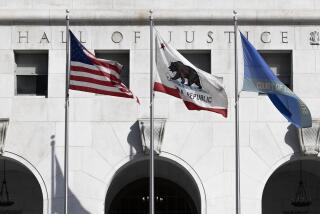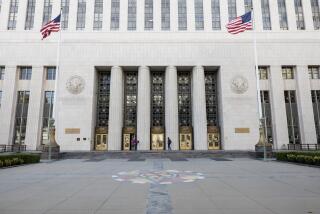Courts Fail to Embrace Technology
- Share via
WASHINGTON — Landing in court doesn’t mean quite what it used to. More than half of civil cases that once were lodged in a federal courthouse now end up in private arbitration.
To a considerable degree, the trend reflects the delays and high costs of settling disputes in government courts, which have made scant use of the information technology that private arbitration groups are embracing.
The 197 federal courts--including bankruptcy courts, district courts and circuit courts of appeal--operate in a technological backwater, lacking automated systems and relying instead on paper. What computer systems are available are often outdated.
Judges, who control the courts, are generally unwilling to push technology development or even use it when available.
“A lack of knowledge, understanding and skills in the area of information technology has hindered the ability of many federal judges and their staff to fully utilize the automation equipment and capabilities available to them in their daily work,” according to a modernization plan issued this year by the Administrative Office of the U.S. Courts.
Of the court’s 26,000 employees, about 5,400 work in clerks’ offices, where many push around tons of pleadings, depositions and orders. By comparison, private arbitration programs are tapping technology to speed decisions and cut costs for the parties in disputes.
“We have done cases with all-electronic pleadings and electronic evidence submission,” said Steven G. Gallagher, senior vice president of the American Arbitration Assn. “We recently instituted the virtual magistrate program, which has an online arbitrator, and issues are resolved online.”
As a result, Gallagher said his association, the largest arbitration group in the nation, is gaining cases faster than federal courts.
That’s fine by the courts, which don’t regret their loss of any market share, according to David A. Sellers, a spokesman for the Administrative Office.
Pamela B. White, the office’s assistant director of information technology, says any shortcomings in information technology have no impact on the work of judges and that automation could not be blamed for a single delay in a legal proceeding. Many federal judges, she says, enthusiastically support technology modernization.
But the court-modernization plan portrays a far different picture. Even in its routine operations, the court system is facing serious problems, including an aged payroll system that it borrowed from the Agriculture Department.
“The current automated payroll system is systemically outdated, and the structural integrity of the system cannot be guaranteed,” according to the plan. “The current system lacks the basic audit capabilities of a payroll system.”
Meanwhile, the Supreme Court, which is administered separately from the rest of the federal judiciary, has set a backward tone for the entire legal system, critics say. The court, for example, forbids attorneys from entering the courtroom with a laptop computer.
Asked if the high court is ever accused of being backward, a Supreme Court spokeswoman said: “All the time . . . but I wouldn’t say that.”







